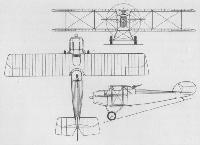А.Шепс Самолеты Первой мировой войны. Страны Антанты
Чтобы довести скоростные и маневренные характеристики HD.3 до требуемых командованием ВВС, конструкторы фирмы "Анрио" установили на самолет 8-цилиндровый, 'жидкостного охлаждения, рядный, V-образный двигатель "Испано-Сьюиза" HS 8E мощностью 325 л. с. В конструкцию самолета были внесены следующие изменения. Во-первых, новый двигатель и лобовой радиатор потребовали новой конструкции капота. Патрубки выхлопных коллекторов выводились за кабину стрелка вдоль бортов. Во-вторых, для обеспечения необходимой центровки верхнее крыло не имело выноса как на HD.3 C2. Над местом пилота в центроплане был вырез для обеспечения обзора вверх. В связи с массой машины был увеличен размах крыльев и установлена дополнительная пара стоек. В остальном конструкция HD.5 C2 повторяла конструкцию HD.3 C2. Эта машина послужила основой для послевоенного морского истребителя HD.7 С2 и разведчика HD.9 А2. Самолет HD.3 С2 стал основой для разведчика и легкого бомбардировщика Н.6 А2, построенного после войны.
Показатель HD.5 С2 1918г.
Размеры, м:
длина 7,97
размах крыльев 10,40
высота 2,75
Площадь крыла, м2 29,5
Двигатель: "Испано-Сьюиза"
мощность, л. с. 325
Потолок практический, м 6200
Экипаж, чел. 2
Вооружение 4 пулемета
Показать полностью
J.Davilla, A.Soltan French Aircraft of the First World War (Flying Machines)
HD.5
The HD.5 was a development of the HD.1, intended to fill the C2 requirement for 1918. This category called for a two-seat aircraft with fixed forward machine guns for the pilot and twin machine guns on a ring mount for the observer. The aircraft was also to be capable of high-speed reconnaissance missions carrying a camera in place of the observer's machine guns. It was to have a speed of 220 km/h at 5,000 meters, a minimum speed of 110 km/h, a service ceiling of 8,000 meters, and a payload of 375 kg. A number of aircraft were designed to meet the C2 specification, those using the 300-hp Hispano-Suiza 8F included the Borel-Boccaccio 3000, BAJ fighter, and HD.5.
The main differences from the HD.1 were the fitting of a 300-hp Hispano-Suiza 8F engine, provision for a second crewman, and a larger wing. The two-bay wings were unstaggered and of equal span. The crew were seated in close proximity, the pilot in a prominent cutout in the top wing. The ailerons, rudder, and elevators were horn-balanced. Armament consisted of two fixed 7.7-mm Vickers machine guns and one or two 7.7-mm Lewis guns.
The aircraft was tested in the summer of 1918. Available performance figures include a maximum speed of 213 km/h (slower than the required speed for the C2 class), a ceiling of 6,200 meters (again lower than the 8,000 specified), and a payload of about 450 kilograms (higher than the required 375 kilograms).
Based on these figures, it is not surprising that further development of the HD.5 was abandoned and Hanriot turned his attention to another design to fill the C2 category - the HD.6.
HD.5 Two-Seat Fighter with 300-hp Hispano-Suiza 8F
Span 10.63 m; length 7.34 tn; height 2.54 m; wing area 30.40 sq. m
Empty weight 800 kg; loaded 1250 kg
Maximum speed: 213 km/h; climb to 2000 m in 6.2 minutes; ceiling 6,200 m; range 425 to 490 km
Armament: two fixed 7.7-mm Vickers machine guns and one or two 7.7-mm Lewis guns
One built
Показать полностью
W.Green, G.Swanborough The Complete Book of Fighters
HANRIOT HD.5 France
Encouraged by the success that attended the HD.3, Emile Dupont designed another two-seat fighter around the excellent Hispano-Suiza 8Fb water-cooled engine of 300 hp. Unlike preceding Dupont designs, the HD.5 was an unstaggered two-bay biplane with an extremely small wing gap. The forward portion of the upper wing centre section was cut out to accommodate the pilot’s head, the aft portion also being cut away to improve the field of fire of the gunner. Armament comprised two synchronised 7,7-mm Vickers machine guns and either one or two 7,7-mm Lewis guns on a flexible mount in the rear cockpit. Only one prototype of the HD. 5 was built, flight testing commencing in the late spring of 1918, but further development was not pursued.
Max speed,132 mph (213 km/h) at sea level.
Range, 304 mis (490 km).
Empty weight, 1,764 lb (800 kg).
Loaded weight, 2,756 lb (1250 kg).
Span, 34 ft 10 1/2 in (10,63 m).
Length, 24 ft 0 7/8 in (7,34 m).
Height, 8 ft 4 in (2,54 m).
Wing area, 327.23 sqft (30,40 m2).
Показать полностью




